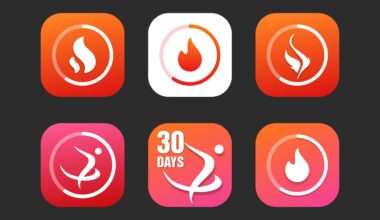Customizing HIIT Workouts Based on Cardiovascular Goals
High-Intensity Interval Training (HIIT) is an efficient workout method that focuses on short bursts of intense exercise. One of the primary benefits of HIIT is its positive impact on cardiovascular health. By customizing HIIT workouts above your fitness level, you can target specific cardiovascular goals effectively. Consider starting with a 30-second all-out effort followed by 1-2 minutes of recovery. This ratio can help boost your aerobic capacity. To understand better, you can set fitness goals, ensuring that your workout aligns with heart health. Regularly assess your heart rate during the sessions. This information is key to tailoring your intensity and recovery duration. Search for HIIT programs that specify objectives, such as improving endurance or increasing power. Incorporating strength training also complements cardiovascular HIIT by enhancing muscular fitness, leading to improved heart efficiency over time. Notification of performance improvements often leads to positive reinforcement that encourages consistency in workouts. As you progress, consider adjusting the intensity or duration of your intervals to continue challenging your body. This approach will ultimately lead to significant cardiovascular health enhancements through focused and personalized HIIT routines.
The Importance of Heart Rate Monitoring
Integrating heart rate monitoring into your HIIT workouts adds a significant layer of personalization to your training regimen. Using devices like a heart rate monitor or smartwatch helps track your performance during intense intervals. Aim to exercise within 70-90% of your maximum heart rate, which optimally encourages cardiovascular adaptation. This targeted approach enhances cardiac output and improves endurance. Adjust your workout intensity based on real-time heart rate data. For instance, if your heart rate significantly drops during intervals, consider increasing the effort in subsequent sessions to maintain optimal intensity. It’s also crucial to give yourself adequate recovery time. Elevated heart rates during HIIT are essential, but resting periods allow your heart to recover, which is vital for long-term health benefits. Avoid overtraining by listening to your body. Incorporating recovery days into your routine ensures sustainable exercise. Make sure to include a warm-up and cool-down to enhance recovery and prevent injury. Therefore, utilizing heart rate data not only personalizes your HIIT workouts but also supports safe and effective cardiovascular development through planned intensity and recovery phases.
The structure of your HIIT regimen can significantly affect your heart health outcomes. Start by defining your overall fitness goals to tailor your workouts effectively. Consider focusing on either endurance or power intervals based on your cardiovascular goals. For endurance, longer intervals, such as 2-3 minutes of high-intensity work followed by equal or longer recovery times, will encourage aerobic development. Alternatively, for power building, you could implement shorter bursts, 20-30 seconds of max effort, followed by a proportionate rest period. This structure enhances your anaerobic strength while improving cardiovascular efficiency. Aim to combine different interval lengths throughout the week to maintain motivation and challenge your cardiovascular system. Variety will also stimulate your heart and prevent plateaus. Training adjustments every 4-6 weeks help ensure continued progress. Pay attention to your perceived exertion levels; higher perceived effort means more significant cardiovascular gains. Regularly evaluating your workouts and adjusting them accordingly enhances your cardiovascular goals effectively, making HIIT not just about intensity but about intelligent design and execution to cultivate lasting health improvements.
Nutrition plays a vital role in supporting your HIIT training and cardiovascular goals. Consuming a balanced diet rich in whole, nutrient-dense foods can optimize your performance. Focus on carbohydrates, healthy fats, and lean proteins to give your body the fuel necessary for high-intensity activities. Pre-workout meals should include easily digestible carbohydrates for sustained energy. Post-workout meals should focus on protein to help repair muscles. Hydration is equally crucial; staying hydrated maintains optimal heart function during strenuous exercise. Ensure you drink water before, during, and after workouts. If you prefer, use electrolyte-replenishing drinks to restore balance after intense sessions. Additionally, monitoring your macronutrient intake can refine your energy levels. Explore different meal timing strategies, such as eating before workouts versus after, to see what works best for your body. Supplementation can also provide nutritional support, particularly for athletes engaging in intense HIIT. Focus on supplements like omega-3 fatty acids, which help maintain cardiovascular health. Customizing your nutrition alongside your HIIT regimen enhances overall performance and cardiovascular benefits, fostering a holistic approach to fitness.
Choosing the Right HIIT Exercises
The selection of exercises in your HIIT workouts can significantly influence your cardiovascular performance. Compound movements, such as burpees, kettlebell swings, and squats, engage multiple muscle groups, resulting in greater cardiovascular demand. When choosing exercises, consider your fitness level and any potential limitations. Start with bodyweight movements if you’re new to HIIT, gradually incorporating weights as you gain confidence and strength. Each exercise should focus on maximizing effort during intervals, promoting increased heart rate for a challenging session. Aim for a mix of aerobic and anaerobic exercises for well-rounded conditioning. Aerobic movements such as running, cycling, or rowing can be alternated with anaerobic selections like jump squats or mountain climbers. The strategic combination of different types of exercises attacks cardiovascular fitness from multiple angles, ensuring a comprehensive effect. Keep in mind personal preferences as well; choosing exercises you enjoy helps with adherence and motivation. Experimenting with various formats and exercises can enhance your experience while achieving your cardiovascular goals through structured, engaging, and powerful HIIT routines.
Consistency is crucial in reaping the cardiovascular benefits of HIIT workouts. Establish a workout schedule that accommodates your lifestyle, ensuring your HIIT sessions become a part of your routine. Frequency assessments play a vital role. Aim for 2 to 3 HIIT sessions weekly, allowing recovery days to avoid burnout or injury. You may also incorporate lighter aerobic activities on off days, such as walking or swimming. These activities maintain cardiovascular activity while promoting recovery. Over time, consider increasing the frequency of your HIIT workouts as your endurance builds. Regular evaluations of your progress motivate adherence to your fitness objectives. Keep a training journal to track your workouts and results; this provides valuable insight into your development. Celebrate small victories, as acknowledging achievements enhances motivation. Set both short-term and long-term goals to maintain your focus and direction. Incorporate community support, like group classes or workout partners, for additional motivation. Ultimately, consistent implementation and accountability lead to substantial cardiovascular gains through HIIT, as both quantity and quality help cultivate lasting habits ensuring sustained fitness progress.
Evaluating Progress in HIIT
Monitoring progress is essential to understand the effectiveness of your customized HIIT workouts. Regular assessments can affirm achievements and identify areas for improvement. Assess fitness levels regularly using various metrics, such as tracking heart rate recovery time, the ability to increase the number of intervals, or reducing breathing rates during sessions. Each of these indicators reflects cardiovascular fitness advancements. Consider using fitness assessments such as maximal oxygen consumption (VO2 max) tests or taking note of your perceived effort levels during workouts to evaluate improvements. Tracking weight fluctuations or body composition changes can also provide insights, but remember that these metrics can vary from individual to individual. Setting specific performance goals could offer a more accurate measure of progress, such as completing a certain number of intervals successfully or decreasing time during sprints over weeks. Collecting data systematically can highlight trends and motivate adjustments to your workouts. Observing your journey not only enhances accountability but reinforces your commitment to achieving cardiovascular health goals. Ultimately, continuous monitoring transforms the abstract concept of fitness into tangible progress and outcomes, leading to customized and effective HIIT results over time.
Embarking on a HIIT journey focuses on individual health goals and ensures you achieve maximum cardiovascular health. Examine the customization of your workouts, emphasizing the importance of heart rate monitoring, nutritional support, appropriate exercise selection, and progress evaluations. Implement systematic changes while keeping enjoyment and consistency in mind. It results in sustainable improvements, as personalized HIIT transformed individuals can have significant enhancements in cardiovascular health. Ultimately, holding on to your goals while adjusting routines leads to optimal benefits with HIIT for cardiovascular improvements, making it a practical and effective choice for anyone seeking enhanced heart health. By employing structured approaches and gradually adapting strategies, you can create a tailored fitness program that meets your needs, drives success, and enhances overall well-being through efficient cardiovascular workouts. Take the time to invest in your fitness endeavors, and witness the changes unfold for a healthier future, furthering your experience through this innovative training style. Embrace the power of HIIT as it reshapes your routine with transformative health advantages, ensuring you build a sustainable path to fitness with positively visible impacts on your heart health.


